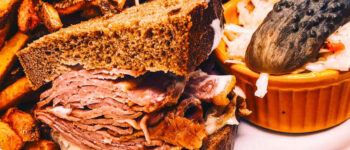How many times have you been to the supermarket, picked out a seemingly fresh cucumber, to then get home and it’s awful? When it comes to choosing the perfect cucumber, it’s not always easy to tell if it’s good or bad just by looking at it. While a fresh cucumber should be firm, smooth, and vibrant in color, it’s not always a guarantee that it’s good on the inside. In fact, many cucumbers can look perfectly fine on the outside but be bad on the inside, which can be disappointing when you’re looking forward to a fresh and crunchy salad. So, how do we tell if a cucumber is bad inside? Let’s look into it!
How to Tell if a Cucumber is Bad Inside…
When it comes to identifying a bad cucumber, there are a few telltale signs to look out for. First and foremost, check the texture of the cucumber. A bad cucumber will typically be soft and mushy to the touch, indicating that it is overripe or starting to rot.
Another indicator of a bad cucumber is the presence of mold. If you notice any fuzzy or powdery spots on the skin of the cucumber, it’s a sign that it has started to grow mold. Similarly, dark spots or soft spots on the cucumber can indicate that it is starting to spoil.
Discoloration is another sign that a cucumber is going bad. If you notice any brown or black spots on the skin of the cucumber, it’s a sign that it has started to rot. Translucent or slimy areas on the cucumber can also indicate that it is starting to spoil.
Finally, pay attention to the smell of the cucumber. A bad cucumber will often have a foul odor, indicating that it is rotten or spoiled.
Understanding Cucumber Freshness
When it comes to cucumbers, freshness is key. A fresh cucumber should be firm to the touch, with a smooth and shiny skin. Ripe cucumbers will have a slightly yellow tint to their skin, but they should still be firm and not mushy.
One way to test the firmness of a cucumber is to gently squeeze it. If it feels soft or mushy, it is likely past its prime. Another indicator of freshness is the water content of the cucumber. Fresh cucumbers will have a high water content, giving them a crisp and refreshing texture. However, if the cucumber has a watery flesh, it may be a sign that it is overripe or has been sitting on the shelf for too long.
Age is also an important factor in determining cucumber freshness. Cucumbers have a relatively short shelf life, typically lasting only a week or two in the refrigerator. If you are unsure of how long a cucumber has been sitting on the shelf, it is best to err on the side of caution and assume it may not be fresh.
It is important to note that while cucumbers may still be safe to eat even if they are not fresh, they may not taste as good and may not have the same nutritional value. To ensure that you are getting the most out of your cucumbers, it is best to choose fresh, firm cucumbers with a high water content.
How to Store Cucumbers
Proper storage is key to keeping cucumbers fresh for as long as possible. Here are some tips on how to store cucumbers to maximize their shelf life:
In the Refrigerator
See more : What Is Liquid Smoke? Learn More About This Barbecue Shortcut
Cucumbers can be stored in the refrigerator to extend their shelf life. Wrap them in a paper towel and place them in an airtight container or plastic bag to prevent moisture loss. This will help keep them fresh for up to a week.
In the Crisper Drawer
The crisper drawer in the refrigerator is designed to keep produce fresh. This is a great place to store cucumbers. To keep them fresh, wrap them in a paper towel and place them in an airtight container or plastic bag before placing them in the crisper drawer.
Without Refrigeration
If refrigeration is not an option, cucumbers can still be stored at room temperature. However, they should be kept away from direct sunlight and heat sources. To prevent moisture loss, wrap them in a paper towel and store them in an airtight container or plastic bag.
Plastic Wrap
Some people prefer to wrap cucumbers in plastic wrap to keep them fresh. While this can be effective, it is important to note that plastic wrap can trap moisture and cause the cucumber to rot more quickly. If you choose to use plastic wrap, be sure to wrap the cucumber tightly and store it in the refrigerator.
Conclusion
Proper storage is essential to keeping cucumbers fresh for as long as possible. By following these tips, you can extend the shelf life of your cucumbers and enjoy them for longer.
Effects of Bad Cucumbers
Consuming a bad cucumber can lead to a range of unpleasant symptoms. Here are some of the effects of bad cucumbers:
Nausea and Vomiting
Eating a bad cucumber can cause nausea and vomiting. The toxins produced by bacteria in a bad cucumber can irritate the stomach lining, leading to these symptoms.
Stomach Cramps
Stomach cramps are another common symptom of consuming a bad cucumber. The cramps can be mild or severe, and can last for several hours.
Diarrhea
Diarrhea is a common symptom of food poisoning caused by bad cucumbers. The body tries to eliminate the toxins produced by the bacteria in the cucumber, leading to loose, watery stools.
Food Poisoning
Food poisoning is a serious condition that can result from consuming a bad cucumber. The symptoms of food poisoning can include nausea, vomiting, stomach cramps, and diarrhea. In severe cases, food poisoning can lead to dehydration and even death.
Disposing of Bad Cucumbers
See more : Potato Salad Recipe
When a cucumber goes bad, it’s important to dispose of it properly to avoid any potential health hazards. Here are a few ways to dispose of bad cucumbers:
Composting
If you have a compost pile, you can add bad cucumbers to it. Cucumbers are a great addition to compost because they are high in water content, which helps to break down other organic matter in the pile. Cut the cucumber into small pieces before adding it to the compost to speed up the decomposition process.
Trash
If you don’t have a compost pile, you can dispose of bad cucumbers in the trash. Wrap the cucumber in a plastic bag before throwing it away to prevent any potential mess or odor.
Recycling
If the cucumber was packaged in plastic, you can recycle the packaging. However, it’s important to remove any remaining cucumber before recycling to prevent contamination.
Frequently Asked Questions
How long does a cucumber last in the fridge before going bad?
Cucumbers can last up to a week in the fridge before they start to go bad. However, it’s best to consume them within 2-3 days of purchase for optimal freshness.
How do you tell if a cucumber is bad by its smell?
If a cucumber has gone bad, it will have a sour or moldy smell. If you notice any unpleasant odor, it’s best to discard the cucumber.
What are the signs that a cucumber has gone bad?
A cucumber that has gone bad will have soft spots, wrinkles, and may even have mold on it. The skin may also turn yellow or brown.
Can you still eat a cucumber that has turned yellow?
A cucumber that has turned yellow may still be safe to eat, but it may have a bitter taste and a softer texture. It’s best to cut off the yellow parts and check the rest of the cucumber for any signs of spoilage.
What are some uses for soft cucumbers?
Soft cucumbers can still be used in recipes such as pickles, soups, and smoothies. They can also be sliced and used as a natural remedy for puffy eyes.
How do you store cucumbers to keep them from going bad?
Cucumbers should be stored in the fridge in a plastic bag or wrapped in paper towels to absorb excess moisture. It’s best to keep them away from fruits like apples and bananas, which release ethylene gas that can cause cucumbers to ripen and spoil faster.
Nigel Gildon editor:Nigel Gildon is the editor of Chef Wayne’s Big Mamou: Chef Wayne’s Big Mamou. He has worked in the publishing industry for many years and has a passion for helping new authors get their work into the hands of readers. 63 Liberty Street * Springfield, MA 01003




